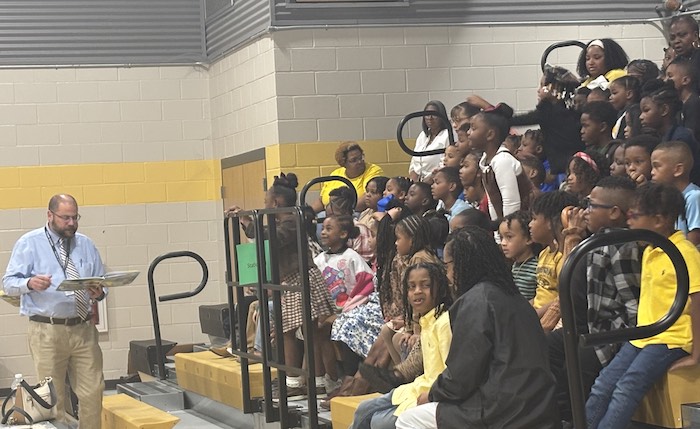Boots and Branches Nature School reimagines early childhood education – LocalNews1.org

Executive Summary: Boots and Branches Nature School Initiative
Introduction
A new educational institution, Boots and Branches Nature School, is scheduled to commence operations in Fayetteville for the upcoming school year. The school will provide nature-based Pre-K and homeschool enrichment programs, representing an alternative learning model for the community. Through a strategic partnership with Greenwood Hills Bible Conference and Camps, the initiative will utilize a safe, outdoor environment to deliver its curriculum. The school’s establishment directly supports the achievement of several United Nations Sustainable Development Goals (SDGs), particularly in the areas of quality education, health, and environmental stewardship.
Alignment with Sustainable Development Goals (SDGs)
SDG 4: Quality Education
Boots and Branches Nature School’s operational model is fundamentally aligned with SDG 4, which aims to ensure inclusive and equitable quality education and promote lifelong learning opportunities for all. The initiative contributes to this goal by:
- Target 4.2: Early Childhood Development: Offering quality early childhood development and pre-primary education to prepare children for subsequent academic stages.
- Target 4.5: Eliminate Disparities in Education: Providing an adaptable and accessible learning environment designed to support students with challenging behaviors who may not thrive in a traditional classroom setting.
- Target 4.7: Education for Sustainable Development: Immersing students in nature to foster an appreciation for the natural world, thereby promoting knowledge and skills needed for sustainable development and sustainable lifestyles.
SDG 3: Good Health and Well-being
The school’s emphasis on outdoor, play-based learning directly supports SDG 3 by promoting physical and mental health. Key impacts include:
- Enhancing cognitive skills, focus, and overall academic success through regular engagement with a natural environment.
- Fostering positive social and emotional skill development through collaborative, purposeful play.
- Promoting physical activity and well-being by utilizing an outdoor “classroom.”
SDG 15: Life on Land
By centering its curriculum in nature, the school actively contributes to the principles of SDG 15, which focuses on protecting, restoring, and promoting the sustainable use of terrestrial ecosystems. The program is designed to:
- Develop a sense of “awe and wonder” in students, fostering a lifelong love and respect for the environment.
- Provide foundational knowledge about the natural world, which is crucial for building a future generation of environmental stewards.
Institutional Framework and Philosophy
Founder’s Vision
The school was founded by Kelli Polly, a former K-2 behavioral teacher who identified a critical need for alternative educational settings. Her experience supporting students who required more than a traditional classroom could offer led to the vision of an adaptable, accessible, and nature-immersed learning environment. This vision is encapsulated in the founding principle that “not all classrooms have four walls, and that nature is the best type of classroom.” The objective is to reconnect students with nature and reimagine the early education experience.
Educational Approach
The curriculum integrates outdoor play with purposeful learning modules to holistically develop social, emotional, and academic competencies. This approach moves beyond conventional classroom structures to create a space where children can learn and explore freely, fostering curiosity and a durable love of learning.
Program Offerings and Enrollment
Scheduled Programs for September 2025
The inaugural school year will feature the following programs:
- Pre-K Nature Learning Program: For children ages 3-6, available two to four days per week.
- Homeschool Enrichment Program: Designed to supplement existing homeschool curricula.
- Family Fridays: Offered in six-week sessions for family participation.
Contact and Enrollment
Parties interested in program details and enrollment can make inquiries via email at info@bootsandbranches.com.
SDGs Addressed in the Article
- SDG 4: Quality Education
- SDG 3: Good Health and Well-being
- SDG 10: Reduced Inequalities
- SDG 15: Life on Land
Specific SDG Targets Identified
-
SDG 4: Quality Education
-
Target 4.2: By 2030, ensure that all girls and boys have access to quality early childhood development, care and pre-primary education so that they are ready for primary education.
The article directly addresses this target by describing the creation of “Boots and Branches Nature School,” which offers a “Pre-K nature learning program” for children ages 3-6. The school’s mission is to “reimagine the early education classroom” and provide a learning environment that may “change the outcome of a child’s early education,” preparing them for future schooling.
-
Target 4.7: By 2030, ensure that all learners acquire the knowledge and skills needed to promote sustainable development… and appreciation of… culture’s contribution to sustainable development.
The school’s philosophy is to “reconnect students with nature” and help them “develop a sense of awe and wonder that will foster a love for this beautiful world that we live in.” This approach directly instills values of environmental appreciation and sustainable lifestyles from an early age, which is a core component of education for sustainable development (ESD).
-
Target 4.2: By 2030, ensure that all girls and boys have access to quality early childhood development, care and pre-primary education so that they are ready for primary education.
-
SDG 3: Good Health and Well-being
-
Target 3.4: By 2030, reduce by one third premature mortality from non-communicable diseases through prevention and treatment and promote mental health and well-being.
The article highlights that the school’s programs combine outdoor play with learning to teach “social, emotional and academic skills.” It also cites the “positive impact on focus, cognitive skills, and overall academic success” that time in nature has for young minds. This focus on social and emotional development contributes directly to the promotion of mental health and well-being in early childhood.
-
Target 3.4: By 2030, reduce by one third premature mortality from non-communicable diseases through prevention and treatment and promote mental health and well-being.
-
SDG 10: Reduced Inequalities
-
Target 10.2: By 2030, empower and promote the social, economic and political inclusion of all, irrespective of age, sex, disability, race, ethnicity, origin, religion or economic or other status.
The founder’s motivation stemmed from her experience with students with “challenging behaviors” who “needed more support than what a large traditional classroom setting could provide.” The article states she imagined a “different type of classroom environment, one that could be adaptable and accessible.” By creating this alternative school, she provides an inclusive educational option for children who may not thrive in conventional settings, thus promoting educational inclusion.
-
Target 10.2: By 2030, empower and promote the social, economic and political inclusion of all, irrespective of age, sex, disability, race, ethnicity, origin, religion or economic or other status.
-
SDG 15: Life on Land
-
Target 15.5: Take urgent and significant action to reduce the degradation of natural habitats, halt the loss of biodiversity and, by 2020, protect and prevent the extinction of threatened species.
While the school itself is not a conservation project, its educational mission is foundational to this target. By fostering “a love for this beautiful world” and immersing children in nature, it cultivates a future generation of citizens who are more likely to value and protect natural habitats and biodiversity. It is an educational strategy to support the long-term goals of conservation.
-
Target 15.5: Take urgent and significant action to reduce the degradation of natural habitats, halt the loss of biodiversity and, by 2020, protect and prevent the extinction of threatened species.
Indicators for Measuring Progress
-
Target 4.2 (Quality early childhood education)
-
Indicator: Participation rate in organized learning.
The article implies this indicator by stating that the school is “accepting students for the upcoming school year” and provides enrollment details for its “Pre-K nature learning program” for children ages 3-6. The number of children enrolled would be a direct measure of progress towards this target in the local community.
-
Indicator: Participation rate in organized learning.
-
Target 4.7 (Education for sustainable development)
-
Indicator: Extent to which education for sustainable development is mainstreamed in curricula.
The article implies this by describing the school’s entire model as being “immersed in nature” and founded on the idea that “nature is the best type of classroom.” The curriculum’s focus on reconnecting students with nature and fostering a love for the world is a direct integration of ESD principles into the school’s educational framework.
-
Indicator: Extent to which education for sustainable development is mainstreamed in curricula.
-
Target 10.2 (Promote inclusion)
-
Indicator: Provision of alternative and accessible learning environments.
The existence of the school itself is an indicator. It was created specifically as an “alternative” to the “traditional classroom” to be more “adaptable and accessible” for children with different needs. The number of such alternative schools and the enrollment of students who require non-traditional support would measure progress.
-
Indicator: Provision of alternative and accessible learning environments.
SDGs, Targets, and Indicators Analysis
| SDGs | Targets | Indicators |
|---|---|---|
| SDG 4: Quality Education |
4.2: Ensure access to quality early childhood development and pre-primary education.
4.7: Ensure all learners acquire knowledge and skills for sustainable development. |
Implied: Participation rate of children (ages 3-6) in the new Pre-K and homeschool enrichment programs.
Implied: The extent to which the school’s curriculum is mainstreamed with education for sustainable development (ESD) through its nature-based model. |
| SDG 3: Good Health and Well-being | 3.4: Promote mental health and well-being. | Implied: Integration of social and emotional skill development into the curriculum, leveraging nature’s positive impact on focus and cognitive skills. |
| SDG 10: Reduced Inequalities | 10.2: Empower and promote the social inclusion of all. | Implied: The provision of an “adaptable and accessible” alternative learning environment for children who need more support than a traditional classroom can provide. |
| SDG 15: Life on Land | 15.5: Take action to reduce the degradation of natural habitats. | Implied: The school’s educational approach to “foster a love for this beautiful world,” which cultivates long-term environmental stewardship in students. |
Source: localnews1.org

What is Your Reaction?
 Like
0
Like
0
 Dislike
0
Dislike
0
 Love
0
Love
0
 Funny
0
Funny
0
 Angry
0
Angry
0
 Sad
0
Sad
0
 Wow
0
Wow
0












































































